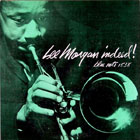

























































































































|
Return to Homepage
SwingJournal #14
Indeed!
Artist : Lee Morgan
Original Recorded Date : November 4th, 1956
Original Label : Blue Note Records
Recorded Location : Rudy Van Gelder Studio Studios in Hackensack, New Jersey
Producer : Alfred Lion
Cat # Blue Note 1538
Roccus : Many jazz fans believe that Lee Morgan was a jazz protege of Art Blakey. But Morgan has many albums as an elder before he joined Jazz Messengers. "Indeed!" is one of them and matter fact that this is Morgan's debut album. The first composition was "Roccus" by the pianist Horace Silver. Prior to this recording, Horace contributed this composition to the alto saxophonist Lou Donaldson's recording "New Faces, New Sound" in 1952.
Audio File
Download Sheet Music for Horace Silver's "Roccus"
Solo Guitar Arrangement/Performance by Hideaki Tokunaga
Reggie of Chester :
Reggie of Chester was written by the great tenor saxophonist Benny Golson.Ê This composition is comprised in an AABA form.Ê The first and second A sections have 10 bars, 10, and the B section has 8 bars and the A section has 14 bars. Last A section has extended 4 bars motives. They use second half of A section (4bars) and this extended 4 bars as the intro of this composition. Lee Morgan plays the first solo with tight rhythm section Silver, Wilbur Ware on bass and Philly Joe Jones on drums. The second soloist is Clarence Sharpe know as "C Sharpe". By listening to C Sharpe's solo, you can immediately tell that Charlie Parker (Bird) strongly influenced C Sharpe. Unfortunately Bird passed away one year and half before this recording.
Benny Golson wrote many jazz compositions like "Along Come Betty" and "Stablemates". Many musicians agree that Golson's composition is little tricky. The relationship between forms and measures are often irregular, and harmonies are also cast off of Bebop tradition chords and progressions.
I assume that Bird never had a chance to play Golson's compositions. Therefore I can imagine that if Bird played Golson's composition, it would be like C Sharpe's solo here. Silver's piano solo follows C Sharpe's solo and they finish with out-chorus melody.
The Lady : After 4 bars of open feel intro, Morgan and C Sharpe play beautiful counter melody. This composition is comprised of four eight-bar phrases in an AABA form. However second and last A section has extra 2 bars to hold the pedal chords. Despite this arranged combinations between Morgan and C Sharpe, the section B is improvisation section for C Sharpe for first half and Morgan for second half. After they play the head-in melody, 18 years old Morgan plays established solo. The rhythm section changes to double time swing feel. After Morgan completed 1 chorus solo, Silver takes the second solo on the AA section. Then C Sharpe plays solo on B section, then Morgan returns to close the composition with the head-out melody on section C. This composition was written by Owen Marshall.
Little T. : Little T was composed by the trumpeter, Donald Byrd. Morgan and C Sharpe's unison triplet notes hit on two beat, then the rhythm section has hits as response to the melody. This medium up tempo composition is comprised of four eight-bar phrases in an AABA form. Lee Morgan plays three chorus of solo with great ideas, then C Sharpe follows as the second soloist and he plays four choruses with nice tone and ideas. Silver is the third soloist, and he only plays two choruses. But Silver only choose melody like phrases, therefore he plays the solo as if it is written melodies. After Silver's solos, Morgan starts playing solo again and this time with his mute on trumpet, and this time he plays 2 choruses. After Morgan's mute solos, the bassist Wilbur Ware keeps playing the steady quarter beats with two notes. It turns out to be a bass solo and Philly Joe takes his 8 bars solo on B section. Ware and Philly Joe get little wild toward the end, but Morgan and C Shape suddenly plays the same unison triplet notes, then ending melody starts.
Gaza Strip
Philly Joe opens with little tricky 8 bars open drums solo intro. The melody is comprised of four four-bar phrases in an ABAB form. They play melodies twice for head-in.
C Sharpe puts little harmony on the 2nd melody. After they play melodies, solos are in minor blues form. C Sharpe plays the first solo. Silver is the 2nd soloist. After Silver's solo, the ensemble play the half of the melody as interlude. Then you can listen to the trumpeter Morgan as a last soloist. Then again they play half of the melody AB and that is the end. As same as "The Lady", this composition was written by Owen Marshall.
Stand By
Even though I mentioned that Benny Golson often writes tricky and challenging composition earlier, "Stand By" was written in commonly acceptable four eight-bar phrases in an AABA form. After four bars of harmonized unison lines on intro, Morgan and C Sharpe alternate union and harmonized melodies. The first solo is by Silver and you can enjoy his Bud Powell influenced solo here. C Sharpe has little hesitation to come right in Silver's solo. I assume there was an eye contact with Morgan, who would take the solo. While C Sharpe is holding a last note of his solo, Morgan appears as a soloist. After Morgan's solo, Ware plays the last chorus solo. He just plays the simple quarter beat walking bass. Ware's simple quarter beat guides whole ensemble to play the closing melody.
|

|
If you like above CD, please try listed below products.
Lee Morgan
|
Gilbert Castellanos
|
Tiger Okoshi
|
Horace Silver
|
Larry Carlton
|
Sal Marquez
|
Freddie Cole
|
Betty Bryant
|
Barbara Morrison
|
|

|

